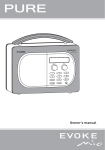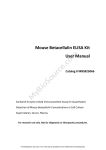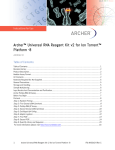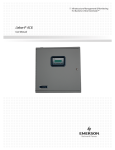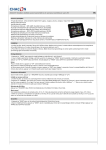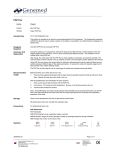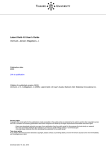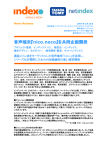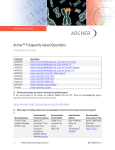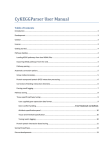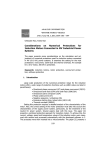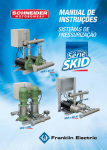Download Oncogene Profiler PAC
Transcript
Genemed PRODUCT ANALYSIS CERTIFICATE Biotechnologies, Inc. Oncogene Profiler Array Nonradioactive System FOR RESEARCH USE ONLY CATALOG #: 05-101 Description: The Oncogene ProfilerTM Array Nonradioactive System employs digoxigenin (DIG)11-dUTP-labeled cDNA and chemiluminescent detection. Each Oncogene Profiler Array contains 295 human genes, which have been spotted onto a positively charged nylon membrane. The spots on the array consists of popular and well-studied genes that have been implicated in cancer and tumorigenesis. Enough reagents are provided for four hybridizations. Package Contents Profiler Array and Hybridization Kit: 2 Oncogene Profiler Arrays 25 ml Hybridization Buffer 60 ml 20X SSC 60 ml 10% SDS Profiler Array cDNA Synthesis Kit: 10 µg Control K562 Total RNA 15 µl Random Primer Mix 15 µl dNTP Mix 100 µl dH20 Profiler Array Chemiluminescence Detection Kit: 15 ml CDP-Star Substrate 30 ml 5X Blocking Buffer 50 ml 10X Antibody Wash Buffer I 50 ml 10X Antibody Wash Buffer II 30 ml 10X Detection Buffer Additional Materials 1 Profiler Grid 1 Product User Manual Storage: Store the Profiler Array and Hybridization Kit at room temperature, Profiler Array cDNA synthesis Kit at –20°C, and Profiler Array Chemiluminescence Kit at 4°C. Shelf Life: 1 year from date of receipt under proper storage conditions. Shipping Conditions: Blue ice (4°C) or room temperature. Quality Control: A sample of this kit was tested according to the user manual. cDNA probes were prepared from Control K562 Total RNA. (PAC0078) Genemed Biotechnologies, Inc. • 458 Carlton Court, South San Francisco, CA 94080 Tel: 877-GENEMED (436-3633) or 650-952-0110 • Fax: 650-952-1060 • Email: [email protected] • www.genemed.com Genemed Biotechnologies, Inc. • 458 Carlton Court, South San Francisco, CA 94080 Tel: 877-GENEMED (436-3633) or 650-952-0110 • Fax: 650-952-1060 • Email: [email protected] • www.genemed.com Ubiq. 2 Abl-2 AF-4 Akt1 Akt2 Akt3 alpha-cate aml-1 APC ARHA AXL BAM22 beta-actin 1 E F G H I J K L M N O P Cot c-mer Ciao1 CHES1 Cdk4 CDH1 c-abl C1ORF1 Brush-1 5 ERbB2 6 E1Ac 4 3 DPH2L DPC4 Doc-1R Doc-1 DLG2 dek DDX6 DDX1 DCC FGF-3 6 5 c-fes FER FAT EXTL3 EXTL2 EXT2 EWSR1 EVI1 ETV6 ETV3 Ets2 Ets1 ERBB4 ERBAL2 EPHA3 EPHA1 EMS1 EMP1 ELK3 ELK1 ELE1 EIF4B EIF3S6 Egr1 EGFR DAL1 dbl ear3 E2F-1 DACH D10S170 CyclinD3 E1B55K ERBB3 CyclinD2 E1B19k 4 CyclinD CRKL CRKII CRK BRCA2 CREBL2 BRCA1 Bmil BLYM BIN1 BECN1 Bcr Bcl3 CDC23 CBL-B 123F2 D Bcl2 CBL 101F6 BCD-ORF2 CAN C BARD1 3 Ubiq. BCD-ORF1 CAV1 beta-actin 2 B A 1 HCK F1t-1 7 FRAT1 FOSL2 FOSL1 c-fos c-fms Flt4 III LAF4 c-kit KAI1 JunD JunB 8 hsReq HPV E7 HPV E6 Hox11 HLF 9 Leu2 Leu1 c-Lck LBC LATS1 MCC max 11 c-myb b-myb MXI1 12 MEL c-maf mad M4S1 M1S1 MSH2 MRVI1 c-mpl NKTR NFkappaB2 NF2 NF1 NEO1 NE-d1g NBL1 n-myc l-myc c-myc 10 beta-actin 11 Ubiq. 12 NOEY2 MASL1 MTCP-1 NOC2 c-mas MAPKAPK3 MAFG c-mos MN1 MLH1 MKK4 c-met LUCA-3 MEN1 LUCA-2 LUCA15 MDM2 MYBL1 LUCA-1 MDA-7 LIBC Leu5 10 HEMK LargeT AG MAFB hdlq-1 GRO1 FLT-1 Flt-3 GLI3 gli2 FLI-1 FKHL1 gli c-jun IRF-4 FHIT Gene 21 FGFR ING1 ING1L Gene 26 JAW-1 Fus-2 9 FGR FRAT2 FGF-6 8 FGF-4 7 Oncogene Profiler Array Schematic 13 PBX3 PBX2 PBX1 PAX2 PAR-4 p73 p57 p53 p21 p16 p15 p107 ODC NTRK1 novH NOV 13 PVT1 15 RAN RALB c-ralA Raf-b c-raf1 14 PTPG1 PTI-1 PTEN PTCH 15 RECK RDA32 RBX1 Rb(p130) TIMP-3 ST13 TLN Tim ST5 TID1 c-src 18 SRP-1 17 Smad5 Smad4 c-ski shc shb 16 c-Lyn c-fyn SPINK1 SPI1 SnoN 18 vav ΤΙΑΜ1 UNPH TSC1 TreORF2 TreORF1 TPO USP4 17 WNT2 wnt-1 v-src VHL VAV3 VAV2 Ubiq. beta-actin 19 19 beta-actin beta-actin beta-actin beta-actin c-yes WT Wnt7a TP53BP2 WNT5 TNF-c TNF-b TNF THRB THRA TGFb-RII TEL TEF TCL-3 TCL-1 TAL1 SUPT6H SUPT5H c-ros1 SUPT3H TM4SF1 RON RhoA Ret c-rel 16 N-ras SMARCB1 Ki-ras Ha-ras PTC-CP Rb(p110) PTC PRLTS PRG1 PP32R1 RARRES3 PLA2P Pim-1 c-Pim2 PFM1 PEP1 PDGFRL A-Raf-1 PDGF-b 14 P O N M L K J I H G F E D C B A Oncogene Profiler Gene List CONTROLS beta-actin Ubiquitin Coordinates A1 & 19; P1, 10, 19 & 24 M24, N24, O24 B1 & 19; P2 & 11 Genbank# X00351, J00074, M10278 M26880 The following gene list is ordered alphabetically for your convenience. Gene Coord. Genbank # Gene name 101F6 123F2 Abl-2 C01 D01 E01 AF040704 AF040703 NM_005158 AF-4 Akt1 Akt2 Akt3 alpha-catenin aml-1 F01 G01 H01 I01 J01 K01 X83606 NM_005163 NM_001626 AF135794 S78736 L34598 APC ARHA L01 M01 M74088 L09159 Homo sapiens putative tumor suppressor protein (101F6) Homo sapiens putative tumor suppressor protein (123F2) Human v-abl Abelson murine leukemia viral oncogene homolog 2 (arg, Abelson-related gene) (ABL2) gene H.sapiens AF-4 gene Human v-akt murine thymoma viral oncogene homolog 1 Homo sapiens v-akt murine thymoma viral oncogene homolog 2 Human AKT3 protein kinase CTNNA1=tumor suppressor gene alpha-catenin Homo sapiens (clone PEBP2aB) aml1 (acute myeloid leukemia 1) oncogene (AML1) Human APC gene Homo sapiens RHOA proto-oncogene multi-drug-resistance protein mRNA, 3' end AXL N01 BAM22 BARD1 BCD-ORF1 BCD-ORF2 Bcl2 BCL3 Bcr BECN1 BIN1 BLYM Bmi1 O01 A02 B02 C02 D02 E02 F02 G02 H02 I02 J02 M76125, NM_061699 L13939 NM_000465 U51869 U51869 M14745 M31732 NM_004327 AF139131 AF068916 K01884 NM_005180 BRCA1 BRCA2 Brush-1 K02 L02 M02 NM_000058 U43746 S69790 C1ORF1 c-abl N02 O02 NM_001213 NM_005157 CAN CAV1 CBL (c-cbl) CBL-B CDC23 CDH1 Cdk4 CHES1 Ciao1 c-mer Cot CREBL2 A03 B03 C03 D03 E03 F03 G03 H03 I03 J03 K03 L03 X64228 S89710 NM_001753 X57110 U26710 AF053977 Z13009 NM_000075 U68723 U63810 NM_006343 D14497 NM_001310 Human tyrosine kinase receptor (axl) Homo sapiens beta adaptin (BAM22) Homo sapiens BRCA1 associated RING domain 1 (BARD1) Human proto-oncogene Bcd orf1 and orf2 Human proto-oncogene Bcd orf1 and orf2 Human bcl-2 Human B-cell lymphoma 3-encoded protein (bcl-3) Human breakpoint cluster region (BCR) gene Homo sapiens beclin 1 (BECN1) mRNA Homo sapiens bridging-integrator protein-1 isoform BIN1-13 Human Blym-1 transforming gene Homo sapiens murine leukemia viral (bmi-1) oncogene homolog (BMI1) Human breast cancer 1 Human breast cancer 2 Brush-1=tumor suppressor {3' region} [human, breast epithelium, mRNA Partial, 1485 nt] Homo sapiens chromosome 1 open reading frame 1(C1ORF1) Homo sapiens v-abl Abelson murine leukemia viral oncogene homolog 1 (Abl-1) H.sapiens can Homo sapiens caveolin 1 (CAV) Human c-cbl proto-oncogene Human cbl-b Homo sapiens cell division cycle protein 23 (CDC23) H.sapiens mRNA for E-cadherin Human cyclin-dependent kinase 4 (CDK4) Human checkpoint suppressor 1 Homo sapiens WD40 protein Ciao 1 Homo sapiens c-mer proto-oncogene tyrosine kinase (MERTK) Human mRNA for proto-oncogene protein Homo sapiens cAMP responsive element binding protein-like 2 Genemed Biotechnologies, Inc. • 458 Carlton Court, South San Francisco, CA 94080 Tel: 877-GENEMED (436-3633) or 650-952-0110 • Fax: 650-952-1060 • Email: [email protected] • www.genemed.com Gene Coord. Genbank # Gene name CRK (c-crk) M03 NM_005206 CRK-II CRKL Cyclin D1 Cyclin D2 Cyclin D3 D10S170 DACH DAL1 dbl DCC DDX1 N03 O03 P03 A04 B04 C04 D04 E04 F04 G04 H04 D10656 X59656 M64349 NM_001759 M90814 S72869 AF102546 AF069072 X12556 X76132 NM_004939 DDX6 dek DLG2 Doc-1 Doc-1R DPC4 (SMAD4) DPH2L I04 J04 K04 L04 M04 N04 O04 D17532 X64229 S89712 X82895 AF006484 NM_005851 U44378 S81752 E1Ac E1B19K E1B55K E2F-1 ear3 EGFR Egr 1 EIF3S6 EIF4B ELE1 ELK1 ELK3 EMP1 EMS1 EPHA1 EPHA3 ERBAL2 ERbB2 (c-erbB2) ERBB3 ERBB4 Ets1 Ets2 P04 A05 B05 C05 D05 E05 F05 G05 H05 I05 J05 K05 L05 M05 N05 O05 P05 A06 B06 C06 D06 E06 M18288 M18288 M18288 M96577 X12795 NM_005228 NM_001964 U62962 NM_001417 X71413 M25269 Z36715 U77085 M98343 M18391 M83941 X12794 X03363 M34309 L07868 J04101 NM_005239 ETV3 ETV6 EVI1 EWSR1 EXT2 EXTL2 EXTL3 FAT FER FES (c-fes) FGF-3 F06 G06 H06 I06 J06 K06 L06 M06 N06 O06 P06 L16464 U11732 S82592 X66899 NM_000401 AF000416 AF083551 X87241 J03358 X52192 NM_005247 Human v-crk avian sarcoma virus CT10 oncogene homolog (CRK) gene Human mRNA for CRK-II H.sapiens crk-like gene CRKL Human cyclin D1 Human cyclin D2 (CCND2) Human D3-type cyclin (CCND3) gene H4(D10S170)=putative cytoskeletal protein Homo sapiens dachshund (DACH) mRNA Homo sapiens putative lung tumor suppressor (DAL1) mRNA Human dbl proto-oncogene Human DCC gene Homo sapiens DEAD/H (Asp-Glu-Ala-Asp/His) box polypeptide 1 (DDX1) Human mRNA for RCK H.sapiens dek mRNA H.sapiens mRNA for DLG2 Homo sapiens putative oral tumor suppressor protein (doc-1) Homo sapiens tumor suppressor deleted in oral cancer-related 1 Human homozygous deletion target in pancreatic carcinoma DPH2L=candidate tumor suppressor gene {ovarian cancer critical region of deletion} Adenovirus type 40 E1A and E1B genes Adenovirus type 40 E1A and E1B genes Adenovirus type 40 E1A and E1B genes Human (E2F-1) pRB-binding protein gene Human v-erbA related ear-3 gene Human epidermal growth factor receptor Human early growth response 1 (EGR1) gene Human Int-6 mRNA Human eukaryotic translation initiation factor 4B (EIF4B) H.sapiens ELE1 mRNA Homo sapiens tyrosine kinase (ELK1) oncogene mRNA H.sapiens mRNA for Net transcription factor Human epithelial membrane protein (CL-20) mRNA Homo sapiens amplaxin (EMS1) mRNA Human tyrosine kinase receptor (eph) mRNA Human receptor tyrosine kinase (HEK) mRNA Human v-erbA related ear-2 gene Human c-erb-B-2 mRNA. Human epidermal growth factor receptor (HER3) mRNA Homo sapiens receptor tyrosine kinase (ERBB4) gene Human erythroblastosis virus oncogene homolog 1 (ets-1) Homo sapiens v-ets avian erythroblastosis virus E26 oncogene homolog 2 (ETS2) mRNA. Human ETS oncogene (PEP1) mRNA Human ets-like gene (tel) mRNA Evi-1=Evi-1 protein {3' region, deletion region} H.sapiens EWS mRNA Homo sapiens exostoses (multiple) 2 (EXT2) mRNA Homo sapiens EXT-like protein 2 (EXTL2) mRNA Homo sapiens exostosin (EXTL3) mRNA H.sapiens mRNA for hFat protein Human tyrosine kinase (FER) mRNA Human c-fes/fps proto-oncogene Human fibroblast growth factor 3 (murine mammary tumor virus integration site (v-int-2) oncogene homolog) (FGF3) Genemed Biotechnologies, Inc. • 458 Carlton Court, South San Francisco, CA 94080 Tel: 877-GENEMED (436-3633) or 650-952-0110 • Fax: 650-952-1060 • Email: [email protected] • www.genemed.com Gene Coord. Genbank # Gene name FGF-4 A07 NM_002008 FGF-6 FGFR B07 C07 X63454 M34185 FGR FHIT FKHL1 FLI-1 FLT-1 Flt-1 D07 E07 F07 G07 H07 I07 M19722 J03429 NM_002012 X74142 X67001, S44250 AF063657 AF063657 Flt3 Flt4 FMS (c-fms) fos (c-fos) FOSL1 FOSL2 FRAT1 FRAT2 Fus-2 Gene 21 Gene 26 J07 K07 L07 M07 N07 O07 P07 A08 B08 C08 D08 Z26652, S64785 X68203 X03663 K00650 M16287 X16707 X16706 U58975 AF062739 AF040706 AF040708 AF040709 gli E08 NM_005269 gli2 GLI3 GRO1 HCK hdlg-1 HEMK HLF Hox11 F08 G08 H08 I08 J08 K08 L08 M08 NM_005270 M57609, M34366 X12510 M16591 U13897 AF131220 M95585 NM_005521 HPV E6 HPV E7 hsReg ING1 ING1L IRF-4 N08 O08 P08 A09 B09 C09 K02718 K02718 U94585 AF110645 NM_001564 U52682 JAW-1 Jun (c-jun) JunB JunD KAI1 Kit (c-kit) LAF4 Large T Ag LATS1 D09 E09 F09 G09 H09 I09 J09 K09 L09 U10485 J04111 X51345 X51346 U20770 X06182 NM_002285 J02400 NM_004690 LBC LCK (c-Lck) LEU1 Leu2 Leu5 M09 N09 O09 P09 A10 NM_006738 NM_005356 Y15227 Y15228 NM_005798 Human fibroblast growth factor 4 (heparin secretory transforming protein 1, Kaposi sarcoma oncogene) (FGF4) H.sapiens hst-2 (FGF-6) mRNA Human fibroblast growth factor receptor (FGFr) transmem brane form mRNA, complete cds Human Proto-oncogene Human fragile histidine triad gene (FHIT) H.sapiens HBF-1 mRNA for transcription factor H.sapiens HUMFLI-1 mRNA Homo sapiens vascular endothelial growth factor receptor Homo sapiens vascular endothelial growth factor receptor (FLT1) mRNA H.sapiens FLT3 mRNA for FLT3 receptor tyrosine kinase H.sapiens mRNA for FLT4, class III receptor tyrosine kinase Human c-fms proto-oncogene Human Proto-oncogene Human fra-1 mRNA Human fra-2 mRNA Homo sapiens proto-oncogene (FRAT1) mRNA Homo sapiens GSK-3 binding protein FRAT2 (FRAT2) Homo sapiens putative tumor suppressor protein (Fus-2) Homo sapiens candidate tumor suppressor gene 21 protein Homo sapiens putative tumor suppressor gene 26 protein alpha 2 delta calcium channel subunit Mrna Homo sapiens glioma-associated oncogene homolog (zinc finger protein) (GLI) mRNA. Homo sapiens GLI-Kruppel family member GLI2 (GLI2) Human DNA-binding protein (GLI3) mRNA Human mRNA for melanoma growth stimulatory activity (MGSA). Human hemopoietic cell protein-tyrosine kinase (HCK) gene Human homolog of Drosophila discs large protein, isoform 1 Homo sapiens HEMK homolog (HEMK) mRNA Human hepatic leukemia factor (HLF) mRNA Homo sapiens homeo box 11 (T-cell lymphoma 3-associated breakpoint) (HOX11) mRNA Human papillomavirus type 16 (HPV16), complete genome Human papillomavirus type 16 (HPV16), complete genome Homo sapiens requiem homolog (hsReq) mRNA Human candidate tumor suppressor p33 ING1 homolog gene Homo sapiens inhibitor of growth 1-like (ING1L) mRNA Human lymphocyte specific interferon regulatory factor/ interferon regulatory factor 4 (LSIRF/IRF4) mRNA Human lymphoid-restricted membrane protein (Jaw1) mRNA Human c-jun proto oncogene Human jun-B mRNA for JUN-B protein. Human jun-D mRNA for JUN-D protein Human metastasis suppressor (KAI1) mRNA Human Proto-oncogene Homo sapiens lymphoid nuclear protein related to AF4 (LAF4) Simian virus 40 Large T Antigen Homo sapiens LATS (large tumor suppressor, Drosophila) homolog 1 (LATS1) mRNA Homo sapiens lymphoid blast crisis oncogene (LBC), mRNA Homo sapiens lymphocyte-specific protein tyrosine kinase Homo sapiens mRNA for leukemia associated gene 1 Homo sapiens mRNA for leukemia associated gene 2 Homo sapiens candidate tumor suppressor involved in B-CLL Genemed Biotechnologies, Inc. • 458 Carlton Court, South San Francisco, CA 94080 Tel: 877-GENEMED (436-3633) or 650-952-0110 • Fax: 650-952-1060 • Email: [email protected] • www.genemed.com Gene Coord. Genbank # LIBC B10 AF143679 LUCA-1 LUCA15 LUCA-2 LUCA-3 M1S1 M4S1 mad Maf (c-maf) C10 D10 E10 F10 G10 H10 I10 J10 MAFB K10 MAFG MAPKAPK3 L10 M10 Mas (c-mas) MASL1 N10 O10 max MCC MDA-7 A11 B11 C11 MDM2 MEL MEN1 Met (c-met) MKK4 MLH1 MN1 D11 E11 F11 G11 H11 I11 J11 Mos (c-mos) Mpl (c-mpl) K11 L11 MRVI1 MSH2 MTCP-1 MXI1 Myb (b-myb) Myb (c-myb) MYBL1 Myc (c-myc) Myc (L-myc) Myc (n-myc) NBL1 NE-dlg NEO1 NF1 NF2 NFkB2 NKTR NOC2 NOEY2 NOV novH TPR M11 N11 O11 A12 B12 C12 D12 E12 F12 G12 H12 I12 J12 K12 L12 M12 N12 O12 P12 A13 B13 C13 Gene name Homo sapiens lost in inflammatory breast cancer tumor suppressor protein (LIBC) mRNA U03056 Homo sapiens putative tumor suppressor (LUCA1/HYAL1) U23946 Human putative tumor suppressor (LUCA15) mRNA NM_003773 Homo sapiens hyaluronoglucosaminidase 2 (HYAL2) mRNA. AF040710 Homo sapiens hyaluronidase (LUCA-3) mRNA X77753 H.sapiens TROP-2 gene M32325 Human adenocarcinoma-associated antigen (KSA) mRNA L06895 Human antagonizer of myc transcriptional activity NM_005360 Human v-maf musculoaponeurotic fibrosarcoma (avian) oncogene AF134157 Homo sapiens MAFB/Kreisler basic region/leucine zipper transcription factor (MAFB) mRNA U84249 Homo sapiens basic-leucine zipper transcription factor MafG NM_004635 Homo sapiens mitogen-activated protein kinase-activated protein kinase 3 (MAPKAPK3) Mrna M13150 Human mas proto-oncogene gene NM_004225 Homo sapiens MFH-amplified sequences with leucine-rich tandem repeats 1 (MASL1), mRNA X60287, S95058 Human max gene M62397 Human colorectal mutant cancer protein mRNA NM_006850 Homo sapiens suppression of tumorigenicity 16 (melanoma differentiation) (MDA-7), mRNA Z12020 Human p53-associated gene S53268 MEL=RAS-related [human, Genomic/mRNA, 1980 nt]. U93236 Human menin (MEN1) gene M60718 Human hepatocyte growth factor gene U17743 Human JNK activating kinase (JNKK1) mRNA U07343 Human DNA mismatch repair protein homolog (hMLH1) NM_002430 Homo sapiens meningioma (disrupted in balanced transloca tion) 1 (MN1) mRNA J00119 Human humos gene homologous to transforming gene of mmsv M90102 Human (clones 15, 39, 41) c-myeloproliferative leukemia virus type P (c-mpl-P) mRNA NM_006069 Homo sapiens murine retrovirus integration site 1 homolog U04045 Human (hMSH2) mRNA Z24459, Z24460 H.sapiens MTCP1 gene, exons 2A to 7 (and joined mRNA). NM_005962 Homo sapiens MAX-interacting protein 1 (MXI1) mRNA X13293 Human B myb oncogene M15024 Human Proto-oncogene X66087 H.sapiens a-myb mRNA E01841, J00120 Human proto-oncogene M19720 Human L-myc protein gene Y00664 Human germ line n-myc gene D28124 Human mRNA for unknown product U49089 Human neuroendocrine-dlg (NE-dlg) mRNA U61262 Human neogenin mRNA M89914 Human neurofibromin (NF1) gene NM_000268 Homo sapiens neurofibromatosis type 2 (NF2) mRNA X61498 H.sapiens mRNA for NF-kB subunit L04288 Homo sapiens cyclophilin-related protein mRNA AF129812 Homo sapiens candidate tumor suppressor protein NOC2 U96750 Homo sapiens putative tumor supressor NOEY2 mRNA X96584 H.sapiens mRNA for NOV protein X78351 H.sapiens novH gene exons 1 and 2 X66397 H.sapiens tpr mRNA Genemed Biotechnologies, Inc. • 458 Carlton Court, South San Francisco, CA 94080 Tel: 877-GENEMED (436-3633) or 650-952-0110 • Fax: 650-952-1060 • Email: [email protected] • www.genemed.com Gene Coord. Genbank # ODC p107 p15 p16 p21 p53 p57 p73 PAR-4 PAX2 PBX1 PBX2 PBX3 PDGF-b (c-sis) PDGFRL PEP1 PFM1 Pim (c-Pim2) Pim-1 PLA2P PP32R1 PRG1 PRLTS PTC PTC-CP PTCH PTEN PTI-1 PTPG1 D13 E13 F13 G13 H13 I13 J13 K13 L13 M13 N13 O13 P13 A14 B14 C14 D14 E14 F14 G14 H14 I14 J14 K14 L14 M14 N14 O14 P14 M34158, J05271 L14812 L36844 L27211 L25610 K03199 U48869 Y11416 NM_002583 M89470 NM_002585 X59842 X59841 X02811 NM_006207 L16464 AF144757 NM_006875 NM_002648 AF145020 AF008216 X96438 D37965 U43148 M31213 U43148 U93051 L41498 S69184 PVT1 A15 A-Raf-1 Raf (c-raf1) Raf-b B15 C15 D15 Ral (c-ral A) E15 RalB F15 RAN G15 RARRES3 Ras (Ha-ras) Ras (Ki-ras) Ras (N-ras) Rb (p110) Rb2 (p130) RBX1 RDA32 RECK Rel (c-rel) H15 I15 J15 K15 L15 M15 N15 O15 P15 A16 Ret RhoA RON B16 C16 D16 Gene name Human ornithine decarboxylase (ODC) gene Human retinoblastoma related protein (p107) gene Human (clone p15INK4B/HA5) CDK inhibitory protein gene Human CDK4-inhibitor (p16-INK4) gene Human cyclin-dependent kinase inhibitor mRNA Human p53 Tumor Antigen Human cdk-inhibitor p57/KIP2 (CDKN1C) gene H.sapiens mRNA for P73 Homo sapiens apoptosis response protein (PAWR) mRNA Human paired-box protein (PAX2) mRNA Homo sapiens pre-B-cell leukemia transcription factor 1 Human PBX2 mRNA Human PBX3 mRNA Human platelet-derived growth factor B chain (PDGF-B) gene Homo sapiens platelet-derived growth factor receptor-like Human ETS oncogene (PEP1) mRNA Homo sapiens PR-domain zinc-finger protein PFM1 mRNA Homo sapiens proto-oncogene Pim-2 (serine threonine kinase) Human pim-1 oncogene (PIM1) gene Homo sapiens phospholipase A2 activating protein (PLA2P) Homo sapiens candidate tumor suppressor pp32r1 (PP32R1) H.sapiens PRG1 gene Human mRNA for PDGF receptor beta-like tumor suppressor Human patched homolog (PTC) mRNA Human papillary thyroid carcinoma-encoded protein mRNA Human patched homolog (PTC) mRNA Human putative protein tyrosine phosphatase (PTEN) gene Homo sapiens longation factor 1-alpha 1 (PTI-1) mRNA PTPG1=tumor suppressor{3' region, clone DC1}[human, colorectal carcinoma cell line DLD-1, mRNA Partial Mutant, 236 nt]. X04620 Human lymphoma pvt-1 locus DNA near t(2;8) translocation breakpoint X04790 Human mRNA for A-raf-1 oncogene X03484 Human mRNA for raf oncogene NM_004333 Homo sapiens v-raf murine sarcoma viral oncogene homolog B1 (BRAF) NM_005402 Homo sapiens v-ral simian leukemia viral oncogene homolog A (ras related) (RALA), mRNA. NM_002881 Homo sapiens v-ral simian leukemia viral oncogene homolog B (ras related; GTP binding protein) (RALB), mRNA NM_006325 RAN, member RAS oncogene familyHomo sapiens RAN, member RAS oncogene family (RAN), mRNA AF060228 Homo sapiens retinoic acid receptor responder 3 (RARRES3) M30708 Synthetic human c-Ha-ras gene encoding p21 protein L00044, K00653 Human cellular c-Ki-ras2 proto-oncogene M14307 Synthetic N-ras gene M28419 Human retinoblastoma susceptibility protein mRNA X74594 Human Rb2/p130 protein AF140598 Homo sapiens ring-box protein 1 (RBX1) mRNA AF061836 Homo sapiens putative tumor suppressor protein (RDA32) E13833 Human tumor suppressor gene,RECK gene NM_002908 Homo sapiens v-rel avian reticuloendotheliosis viral oncogene homolog (REL) mRNA. X12949, M57464 Human ret proto-oncogene for tyrosine kinase L25080 Human GTP-binding protein (rhoA) X70040 H.sapiens RON mRNA for tyrosine kinase Genemed Biotechnologies, Inc. • 458 Carlton Court, South San Francisco, CA 94080 Tel: 877-GENEMED (436-3633) or 650-952-0110 • Fax: 650-952-1060 • Email: [email protected] • www.genemed.com Gene Coord. Genbank # Ros (c-ros1) E16 NM_002944 shb shc Ski (c-ski) Smad4 F16 G16 H16 I16 SMAD5 SMARCB1 SnoN SPI1 SPINK1 J16 K16 L16 M16 N16 src (c-fyn) src (c-Lyn) Src (c-src) SRP-1 ST13 ST5 O16 P16 A17 B17 C17 D17 SUPT3H SUPT5H SUPT6H TAL1 TCL-1 TCL-3 TEF TEL TGFb-RII E17 F17 G17 H17 I17 J17 K17 L17 M17 THRA THRB TIAM1 N17 O17 P17 TID1 A18 Tim TIMP-3 (HUMAN) TLN TM4SF1 TNF TNF-b TNF-c TP53BP2 TPO B18 C18 D18 E18 F18 G18 H18 I18 J18 TreORF1 (210) TreORF2 (213) TSC1 UNPH K18 L18 M18 N18 USP4 O18 vav VAV2 P18 C19 Gene name Homo sapiens v-ros avian UR2 sarcoma virus oncogene homolog 1 (ROS1) mRNA. X75342 H.sapiens SHB mRNA U73377 Human p66shc (SHC) mRNA X15218 Human ski oncogene gene U44378 Human homozygous deletion target in pancreatic carcinoma (DPC4) gene U73825 Homo sapiens Smad5 mRNA Y17118 Homo sapiens SNF5/INI1 gene, exon 1 (and joined CDS). X15219 Human sno oncogene mRNA for snoN protein, ski-related X52056 Human mRNA for spi-1 proto-oncogene Y00705 Homo sapiens pstI mRNA for pancreatic secretory inhibitor (expressed in neoplastic tissue) NM_002037 Human FYN oncogene related to SRC, FGR, YES (FYN) M16038 Human lyn mRNA encoding a tyrosine kinase X59932, X71157 Human C-SRC-kinase U20620 Homo sapiens SRP1 mRNA, partial sequence U17714 Homo sapiens putative tumor suppressor ST13 (ST13) mRNA S45936 HTS1=HeLa tumor suppressor gene [human, revertant clone F2, mRNA Partial, 2687 nt] AF064804 Homo sapiens transcription factor SUPT3H (SUPT3H) U56402 Human chromatin structural protein homolog (SUPT5H) U46691 Human putative chromatin structure regulator (SUPT6H) M29038 Human stem cell protein (SCL) mRNA X82240 H.sapiens mRNA for Tcell leukemia/lymphoma 1 M62626 Human T lymphocyte homeobox protein (partial cds) U06935 Human thyrotroph embryonic factor (TEF) mRNA U11732 Human ets-like gene (tel) mRNA NM_003242 Homo sapiens transforming growth factor, beta receptor II (70-80kD) (TGFBR2) mRNA M24748 Human thyroid hormone receptor alpha 1 (TR-alpha-1) gene M26747 Human c-erbA mRNA U16296 Human T-lymphoma invasion and metastasis inducing TIAM1 protein (TIAM1) mRNA NM_005147 Homo sapiens tumorous imaginal discs (Drosophila) homolog (TID1) mRNA NM_005435 Human Oncogene TIM (TIM) gene U14394 Human tissue inhibitor of metalloproteinases-3 mRNA NM_006289 Homo sapiens talin (TLN) mRNA M90657 Human tumor antigen (L6) mRNA X01394 Human tumor necrosis factor D12614 Human mRNA for lymphotoxin (TNF-beta), L11015 Homo sapiens lymphotoxin-beta mRNA U58334 Human Bcl2, p53 binding protein Bbp/53BP2 (BBP/53BP2) NM_000460 Human thrombopoietin (myeloproliferative leukemia virus oncogene ligand, megakaryocyte growth and development factor) (THPO) gene X63546 H.sapiens mRNA for tre oncogene (clone 210). X63547 H.sapiens mRNA for tre oncogene (clone 213). AF013168 Homo sapiens hamartin (TSC1) mRNA U20657 Human ubiquitin protease (Unph) proto-oncogene mRNA, complete cds NM_003363 Homo sapiens ubiquitin specific protease 4 (proto-oncogene) (USP4) mRNA X16316 Human vav oncogene NM_003371 Homo sapiens vav 2 oncogene (VAV2) mRNA Genemed Biotechnologies, Inc. • 458 Carlton Court, South San Francisco, CA 94080 Tel: 877-GENEMED (436-3633) or 650-952-0110 • Fax: 650-952-1060 • Email: [email protected] • www.genemed.com Gene Coord. Genbank# VAV3 VHL v-src wnt-1 D19 E19 F19 G19 NM_006113 NM_000551 D10652 NM_005430 WNT2 WNT5 Wnt7a WT H19 I19 J19 K19 Yes (c-yes) L19 Gene name Homo sapiens vav 3 oncogene (VAV3) mRNA Homo sapiens von Hippel-Lindau syndrome (VHL) mRNA Rous sarcoma virus genome Human wingless-type MMTV integration site family, member 1 (WNT1) gene X07876, Y00838 Human mRNA for irp protein (int-1 related protein). L20861 Homo sapiens proto-oncogene (Wnt-5a) mRNA D83175 Homo sapiens WNT7a mRNA X51630 Human Wilms tumor WT1 mRNA for zinc finger protein, Krueppel-like M15990 Human c-yes-1 Genemed Biotechnologies, Inc. • 458 Carlton Court, South San Francisco, CA 94080 Tel: 877-GENEMED (436-3633) or 650-952-0110 • Fax: 650-952-1060 • Email: [email protected] • www.genemed.com NOTES Genemed Biotechnologies, Inc. • 458 Carlton Court, South San Francisco, CA 94080 Tel: 877-GENEMED (436-3633) or 650-952-0110 • Fax: 650-952-1060 • Email: [email protected] • www.genemed.com NOTES Trademark ProfilerTM is a trademark of Genemed Biotechnologies, Inc. CDP-Star® is a registered trademark of Tropix, Inc. WARRANTY GENEMED BIOTECHNOLOGIES, INC. WARRANTS THAT THE MATERIALS SOLD MEET GENEMED’S PERFORMANCE SPECIFICATIONS FROM THE TIME OF SHIPMENT UNTIL THE EXPIRATION DATE, IF STORED UNDER THE RECOMMENDED CONDITIONS. NO OTHER WARRANTIES OR GUARANTEES, EXPRESSED OR IMPLIED, ARE PROVIDED, INCLUDING WARRANTIES FOR MERCHANTABILITY OR FITNESS FOR A PARTICULAR PURPOSE. UNDER NO CIRCUMSTANCES SHALL GENEMED BE LIABLE FOR ANY DAMAGES ARISING OUT OF THE USE OF THE MATERIALS. © 2000, Genemed Biotechnologies, Inc. Genemed Biotechnologies, Inc. • 458 Carlton Court, South San Francisco, CA 94080 Tel: 877-GENEMED (436-3633) or 650-952-0110 • Fax: 650-952-1060 • Email: [email protected] • www.genemed.com Genemed Biotechnologies, Inc. • 458 Carlton Court, South San Francisco, CA 94080 Tel: 877-GENEMED (436-3633) or 650-952-0110 • Fax: 650-952-1060 • Email: [email protected] • www.genemed.com Genemed Biotechnologies, Inc. TM Profiler Array Nonradioactive System User Manual (Version 2.2) STORAGE Store Box 1 at room temperature (RT), Box 2 at –20°C, and Box 3 at 4°C. Please note that the Substrate is light sensitive and should be stored in the dark. FOR RESEARCH USE ONLY. (PRT0088) Profiler Array Nonradioactive System TABLE OF CONTENTS I. Introduction II. Package Contents 3 5 III. Additional Materials & Equipment 6 IV. Instructions for Use 6 Troubleshooting Guide 10 V. VI. Appendix 11 TRADEMARKS ProfilerTM is a trademark of Genemed Biotechnologies, Inc. CDP-Star® is a registered trademark of Tropix, Inc. GenBank® is a registered trademark of The United States Department of Health and Human Services. FluorChemTM is a trademark of Alpha Innotech Corporation. HyperfilmTM is a trademark of Amersham Pharmacia Biotech. Saran Wrap® is a registered trademark of S.C. Johnson. WARRANTY GENEMED BIOTECHNOLOGIES, INC. WARRANTS THAT THE MATERIALS SOLD MEET GENEMED’S PERFORMANCE SPECIFICATIONS FROM THE TIME OF SHIPMENT UNTIL THE EXPIRATION DATE, IF STORED UNDER THE RECOMMENDED CONDITIONS. NO OTHER WARRANTIES OR GUARANTEES, EXPRESSED OR IMPLIED, ARE PROVIDED, INCLUDING WARRANTIES FOR MERCHANTABILITY OR FITNESS FOR A PARTICULAR PURPOSE. UNDER NO CIRCUMSTANCES SHALL GENEMED BE LIABLE FOR ANY DAMAGES ARISING OUT OF THE USE OF THE MATERIALS. © 2000, Genemed Biotechnologies, Inc. Page 2 Genemed Biotechnologies, Inc. Profiler Array Nonradioactive System I. INTRODUCTION With the advent of macroarray technology, studying differential gene expression has become relatively easy and routine. The expression profiles of hundreds of genes can be studied simultaneously in a single array experiment. Typically, array experiments require the use of radioactive cDNA probes. However, working with radioactively labeled probes is a hassle, requiring timeconsuming procedures. Furthermore, radioactively labeled cDNA arrays tend to generate high levels of background. The ProfilerTM Array provides researchers with an alternative approach—a hassle-free, nonradioactive array system that employs digoxigenin (DIG)-11dUTP-labeled cDNA and chemiluminescent detection. With this method, you can obtain semiquantitative results in just 1–2 days, compared to 4–7 days that radioactive-based methods demand. Our first array, the Star Profiler Array, contains 373 genes—an exclusive set of the most popular and well-studied genes—spotted onto a positively charged nylon membrane. Star Profiler Array contains genes that play a significant role in biological functions and are corroborated with published literature; thus, a single experiment using Star Profiler Arrays generates highly informative data. In addition, each spot contains long oligonucleotides (>90 nt), synthesized from a carefully selected sequence. Our selection process eliminates any homologous regions among the genes on the array so there is no risk of crosshybridization. As a result, your labeled cDNA probe will hybridize efficiently and selectively to specific sequences on the array. In addition, we offer targeted arrays such as the Oncogene Profiler Array and Apoptosis Profiler Array. For a complete list of genes for each array, see the Product Certificate Sheet provided with each kit. Benefits of the ProfilerTM Array Unlike other macroarrays, which often require poly-A+ RNA, the Profiler Array has no preference for total or poly-A+ RNA. In fact, our method provides equivalent results using either total RNA or mRNA, so there is no need for special RNA purification procedures. Genemed Biotechnologies, Inc. Page 3 Profiler Array Nonradioactive System I. INTRODUCTION continued Sample 1 Sample 2 (e.g., control) (e.g., experimental) Obtain cell or tissue samples AAAA AAAA AAAA AAAA AAAA AAAA TTTT DIG Isolate Total RNA (~1–6 hr) DIG TTTT DIG DIG Prepare Labeled cDNA & Prehybridize Profiler Arrays (~2–3 hr) Hybridization Bag array 1 array 2 Hybridize overnight (~12 hr) Detect & analyze (~3–4 hr) (5-min exposure to x-ray film) Total Time: 1–2 days (~24–28 hr) Figure 1 provides a simplified overview of the Profiler procedure. After cDNA labeling, Profiler Arrays are hybridized overnight with DIG-11-dUTP-labeled cDNA. The next day, the array membranes are washed and subsequently incubated with Anti-DIG-Alkaline Phosphatase (DIG-AP) Antibody. Upon addition of the CDP-Star chemiluminescent substrate (provided), detection of DIG-AP can be obtained within minutes by exposing array membranes to x-ray film or by using a chemiluminescent-imaging system, such as Alpha Innotech's FluorChem Imaging System. Page 4 Genemed Biotechnologies, Inc. Profiler Array Nonradioactive System II. PACKAGE CONTENTS See the front cover of this User Manual for appropriate storage conditions. For Buffer Solutions & Recipes, see Appendix at the back of this User Manual. Profiler Array Nonradioactive System† Profiler Array and Hybridization Kit (Store at room temp.) • • • • 2 25 ml 60 ml 60 ml Profiler Arrays Hybridization Buffer 20X SSC 10% SDS Profiler Array cDNA Synthesis Kit (Store at –20°C) • 10 µg • 10 µl • 15 µl • 15 µl • 50 µl • 100 µl • 100 µl Control K562 Total RNA (yellow) Reverse Transcriptase (amber) Random Primer Mix (blue) Probe Mix (pink) 100mM DTT (salmon) 5X RT Buffer (purple) dH20 (natural) Profiler Array Chemiluminescence Detection Kit (Store at 4°C) • • • • • • 15 ml 30 ml 50 ml 50 ml 30 ml 15 µl CDP-Star Substrate 5X Blocking Buffer 10X Antibody Wash Buffer I 10X Antibody Wash Buffer II 10X Detection Buffer Alk-Phosphatase Conjugate (orange) Additional Materials Provided • 1 Profiler Grid • 1 Product User Manual † See Product Analysis Certificate provided with each kit for complete list of genes spotted on the array. Genemed Biotechnologies, Inc. Page 5 Profiler Array Nonradioactive System III. ADDITIONAL MATERIALS & EQUIPMENT Additional Materials Required • • • • Sheared salmon testes DNA (Sigma, Cat. #D7656) Hyperfilm ECL Film (Amersham, Cat. #RPN31144) Plastic wrap (e.g., Saran Wrap) or plastic sheet protectors Commercial pouch sealer or equivalent Additional Materials Recommended • Trizol (Life Technologies, Cat. #15596-018) or equivalent Additional Equipment • Thermal cycler or water bath • Temperature controlled Shaking or Rotating platform • [Optional] Hybridization oven and bottles (Stratagene Cat. #401031) • [Optional] Alpha Innotech FluorChem or equivalent IV. INSTRUCTIONS FOR USE A. Isolation of total RNA from cells or tissues Total RNA can be isolated from tissues or cells using standard methods (e.g., Trizol or equivalent). You can use poly-A+ RNA if you wish; however, we have found that equivalent results can be achieved using total RNA. Quantify your RNA samples by measuring the absorbance at 260 nm and 280 nm. Total RNA samples that are free of proteins have an A260/A280 ratio of ~1.8–2.2. In addition, you should check the quality of your RNA by agarose gel electrophoresis. Run 0.5–2.0 µg of RNA on a denaturing formaldehyde/agarose/ethidium-bromide gel. Two bright bands, 28S and 18S rRNA, should be observed at approximately 5 and 2 kb, respectively. These bands are sharply defined and visible at about a 2:1 ratio (28S:18S). B. Preparation of cDNA probe For best results, we recommend using a thermal cycler for all incubation steps; however, if a thermal cycler is unavailable, heating blocks may be used. If desired, first perform prehybridization (Step C.1–4), and then prepare RNA (Step B.2) and cDNA synthesis mixture (Step B.4), simultaneously. 1. Preheat a thermal cycler or heating block (or equivalent) to 70°C. Page 6 Genemed Biotechnologies, Inc. Profiler Array Nonradioactive System IV. INSTRUCTION FOR USE continued 2. For each total RNA sample, combine the following components into a sterile 0.5-ml microcentrifuge tube: 5–10 µg Total RNA 3 µl Random Primer Mix Bring each tube to a final volume of 10 µl by adding dH2O (provided). Mix well by pipetting and spin briefly in a microcentrifuge. Keep on ice. 3. Heat samples at 72°C for 2 min. Then reduce temperature to 42°C and incubate for 1–2 min. Note: If a heating block is used, tubes must be incubated for a minimum of 2 min at 42°C. 4. Prepare the cDNA synthesis mixture for each total RNA sample: 6 µl 5X First Strand Buffer† 3 µl 0.1 M DTT† 6 µl Probe Mix 1 µl Reverse Transcriptase 4 µl H2O (provided) 20 µl Total volume per RNA sample 5. Mix well by pipetting. Incubate the cDNA synthesis mixture at 42°C for 2 min. 6. Transfer the mixture to the tube containing the RNA sample (from Step B3) and mix well by pipetting. Then incubate at 42°C for 2 hr. 7. After incubation, samples at 75°C for 10 min to inactivate RT. Proceed directly to Step D (Hybridization) or store DIG-labeled cDNA probe(s) at –20°C until use. C. Pre-Hybridization Before you start, preheat Hybridization Buffer to 52°C. Completely dissolve all precipitates in the Hybridization Buffer. Prepare sheared salmon testes DNA: 1. Heat the sheared salmon testes DNA (~10 mg/ml) at 95–100°C for 5 min, then immediately place on ice (~5 min). We recommend preparing aliquots of 100 µl (i.e., 50 µl per membrane), then storing at –20°C until use. 2. Place each membrane into a hybridization pouch with the spots facing up. (Note the orientation of the membranes. The correct orientation is shown in the Appendix, indicating that the notch is on the top, right-hand corner.) Fill the pouch entirely with pre-warmed 5 ml deionized H2O; avoid adding H2O directly onto the membrane. Then carefully decant water. 4. For each membrane, prepare pre-hybridization solution: Add 50 µl of the sheared salmon testes DNA to 5ml of pre-warmed Hybridization Buffer. After mixing, add 5 ml of pre-hybridization solution to each pouch containing the membrane. Remove bubbles before sealing the pouch. Incubate at 52°C for ≥ 2 hr. Genemed Biotechnologies, Inc. Page 7 Profiler Array Nonradioactive System IV. INSTRUCTIONS FOR USE continued D. Hybridization 1. Heat DIG-labeled cDNA probe at 94°C for 5 min. Then incubate on ice for 5 min. 2. Cut open hybridization pouch, add each DIG-labeled cDNA probe directly to the Hybridization Buffer (Step C.4), reseal pouch and hybridize overnight (≥ 12 hours) at 52°C. 3. The next day, prepare SSC/SDS washing solutions as described in the Appendix. Preheat SSC/SDS solutions to 52°C before use. Ensure that the SSC/SDS solutions are free from all precipitates. Shake well before use. 4. Cut open hybridization pouch, decant cDNA probe/buffer and place membrane into a clear plastic container such as a 200 µl pipet tip container. Quicky rinse each membrane with 10 ml 2X SSC/0.5% SDS and decant. Wash twice with 30 ml of prewarmed 2X SSC/0.5% SDS at 52°C for 10 min per wash. Then wash twice using 30 ml of prewarmed 0.1X SSC/0.5% SDS at 52°C for 10 min per wash. Keep SSC/SDS solutions at 52°C during wash steps. E. Detection Note that all incubation and wash steps, below, should be performed on a rotating platform with moderate shaking at room temp. 1. Blocking: Decant 0.1X SSC/0.5% SDS washing solution and add 30 ml of 1X Blocking Buffer to each container. 2. Incubate at room temperature for 30 min. 3. Prepare anti-DIG-AP Antibody Mixture: For each membrane, mix 1 ml of 1X Blocking Buffer and 6 µl of anti-DIG-AP Antibody. Mix well. Add the 1-ml mixture to each container, and incubate at room temperature for 30 min. Note: Be sure to spin the antibody conjugate for 5 minutes at maximum speed before diluting in 1X Blocking Buffer. Some lots may contain aggregated conjugates that precipitate and can cause a spotty background on the membrane. 4. Wash the membranes at room temperature: Remove the anti-DIG-AP Antibody Mixture/Blocking Buffer, and wash twice using 40 ml of 1X Antibody Wash Buffer I for 10 min per wash. Then repeat washes using 40 ml of 1X Antibody Wash Buffer II for 10 min per wash. 5. Dilute CDP-Star Substrate in 1X Detection Buffer (1:30 for x-ray film or 1:10 for Imager). Incubate each membrane in 30 ml diluted substrate for 30 minutes at room temperature. 6. Using forceps, remove each membrane from the diluted substrate. Do not allow the membrane to dry. We recommend placing the membrane on a plastic support, such as a developed/used x-ray film. Page 8 Genemed Biotechnologies, Inc. Profiler Array Nonradioactive System IV. INSTRUCTIONS FOR USE continued 7. Immediately cover each membrane with plastic wrap (e.g., Saran Wrap) or plastic sheet protectors, and remove excess substrate. Avoid air bubbles. Expose the membrane to Hyperfilm ECL (Amersham Cat. #RPN31144) for 3–10 min at room temperature. We suggest trying several different exposures of varying lengths of time (i.e., 2–10 min). Alternatively, use a chemiluminescent-imaging system, such as Alpha Innotech's FluorChem Imager or equivalent. F. Interpretation of results For quantitative results, we suggest using an chemiluminescent-imaging system such as Alpha Innotech's FluorChem or equivalent. Be sure to read Section G (below) to find out how to normalize the genes on the arrays. For a quick, cursory analysis of results, you may perform the following: 1. Place the two x-ray images together such that the housekeeping genes are aligned. 2. Slowly shift one x-ray film to the left or right, and observe any differences in spot intensity. Spots that exhibit differences in signal intensity may indicate that a gene is upregulated or downregulated; however, results are not conclusive until you have normalized the genes on the arrays. G. Normalization On each array, two housekeeping genes (beta-actin and ubiquitin), have been spotted at different locations on the array. Four beta-actin spots have been placed on the lower right hand corner for orientation purposes, see Appendix. Select one housekeeping gene. On each array, take the average intensity for the housekeeping gene of your choice and use this value as the baseline. Normalize each spot with respect to the average value of the housekeeping gene. After normalizing each array, compare spot intensities on separate arrays for each gene. Generally, a threefold increase or decrease in spot intensity is considered significant. Genemed Biotechnologies, Inc. Page 9 Profiler Array Nonradioactive System V. TROUBLESHOOTING GUIDE The following list of tips is designed to help you troubleshoot problems that you may encounter when performing the procedure. If you feel you need additional technical assistance, please contact us by phone, fax, or email. A. Problem: high background •Was the membrane completely immersed in solution during the incubations? Never let the membrane dry out, and be sure membrane is completely immersed during all incubations. If desired, paper clips can be used to clip membranes to the bottom of the plastic containment during washing/blocking/ detection steps. Use extreme caution when using this method. •Was the membrane completely covered in the solutions during detection? Be sure solutions completely cover the membrane during these steps. •Were the hybridization solutions completely dissolved? Check Hybridization Buffer for visible precipitated particles. •Is the film overexposed? Try several exposures for varying lengths of time. This is necessary for obtaining optimal results. •How much antibody did you add to the Blocking Buffer (in Step E3)? Make sure the antibody is diluted 1:5,000. B. Problem: hybridization signals weak or absent • Is the problem with your RNA quality? Be sure to check the quality of your RNA (Section IV.A). •Are the kit reagents working properly? Strip the membrane and use the control K562 RNA (provided) to confirm that reagents and materials are working properly. •Did you hybridize the membrane at the correct temperature? Check to make sure the hybridization temperature is set at 52°C. •How long was the hybridization time? An overnight hybridization (~12 hours) is necessary for optimal binding of the probe to the array. • How much CDP-Star substrate did you use? Make sure that the substrate is evenly distributed over the membrane during detection (Step E5). •How long was the exposure? Try several exposures for varying lengths of time. This is necessary for obtaining optimal results. Page 10 Genemed Biotechnologies, Inc. Profiler Array Nonradioactive System VI. APPENDIX Genemed Biotechnologies, Inc. BOTTOM TOP Notch Beta-actin spots Array Orientation Page 11 VI. APPENDIX continued Solution/Dilution Recipes (enough for two array membranes) 250 ml of 2X SSC/0.5% SDS To 212.5 ml of deionized H2O, add 25 ml of 20X SSC stock solution and 12.5 ml of 10% SDS stock solution. Shake well before use. 250 ml of 0.1X SSC/0.5% SDS To 236.25 ml of deionized H2O, add 1.25 ml of 20X SSC stock solution and 12.5 ml of 10% SDS stock solution. Shake well before use. 75 ml of 1X Blocking Buffer To 60 ml of deionized H2O, add 15 ml of 5X Blocking Buffer stock solution. Shake well before use. 200 ml of 1X Antibody Wash Buffer I To 180 ml of deionized H2O, add 20 ml of 10X Antibody Wash Buffer I stock solution. Shake well before use. 200 ml of 1X Antibody Wash Buffer II To 180 ml of deionized H2O, add 20 ml of 10X Antibody Wash Buffer II stock solution. Shake well before use. 100 ml of 1X Detection Buffer To 90 ml of deionized H2O, add 10 ml of 10X Detection Buffer stock solution. Shake well before use. Genemed Biotechnologies, Inc. 458 Carlton Court South San Francisco, CA 94080 Tel: 650-952-0110 Toll Free (USA & Canada): 1-877-GENEMED (436-3633) Fax: 650-952-1060 Email: [email protected] • www.genemed.com Technical Support Tel: 650-952-0110 Toll Free (USA & Canada): 1-877-GENEMED (436-3633) Fax: 650-952-1060 Email: [email protected]

























